🖋️ Written by Emma
Pistachio cake is a surprisingly simple treat packed with rich flavor and a soft, moist texture that melts in your mouth. Whether you’re baking for a family gathering or just craving something sweet with a twist, this cake delivers a unique combination of nuttiness and nostalgia.
What makes pistachio cake stand out isn’t just the color—it’s the secret ingredient that turns an ordinary dessert into something unforgettable. In this article, you’ll discover four quick and beautiful ways to make it, plus expert tips to avoid dry crumbs or bland flavor. Ready to bake a cake that gets everyone asking for seconds?
Pistachio Cake Origins and Popularity
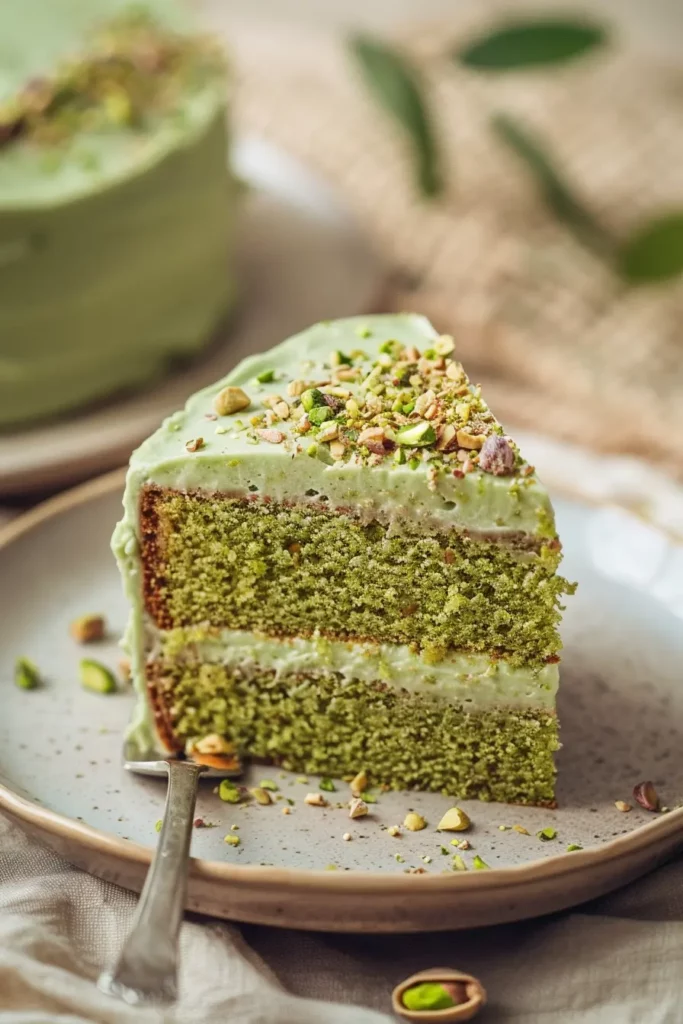
Where Pistachio Cake Comes From
Pistachio cake may seem like a modern invention, but its roots go back decades. Popularized in American kitchens during the 1970s, this dessert gained fame for its bright green color and light nutty flavor. Originally made with instant pudding mixes and boxed cake, it quickly became a staple at potlucks and family holidays.
Over time, the recipe evolved. Bakers began using real pistachios, homemade batter, and natural flavorings. Despite the changes, the heart of the cake remained the same—comforting, nostalgic, and slightly whimsical. Today, it’s enjoyed around the world in both classic and reinvented forms.
Why Pistachio Cake Is Loved by So Many
There’s something special about the balance of flavor in a pistachio cake. The nuttiness is subtle, never overwhelming. The texture stays moist for days, making it ideal for prepping ahead. And visually? The pale green crumb adds a playful, elegant touch that stands out on any dessert table.
It’s not just the taste that keeps people coming back. The cake feels familiar yet different. It’s simple enough for beginner bakers, but still impressive enough for special occasions. For many, it strikes the perfect chord between tradition and creativity.
Best Pistachio Cake Frosting Ideas
Classic Buttercream with Pistachio Flavor
Frosting can make or break a pistachio cake. One of the best pairings is a light, fluffy pistachio buttercream. To make it, start with softened unsalted butter, powdered sugar, a touch of milk, and pistachio paste. The paste adds intense nutty depth, naturally enhancing the cake without artificial flavorings. You can also pulse shelled pistachios into a fine meal and blend them into the frosting for texture.
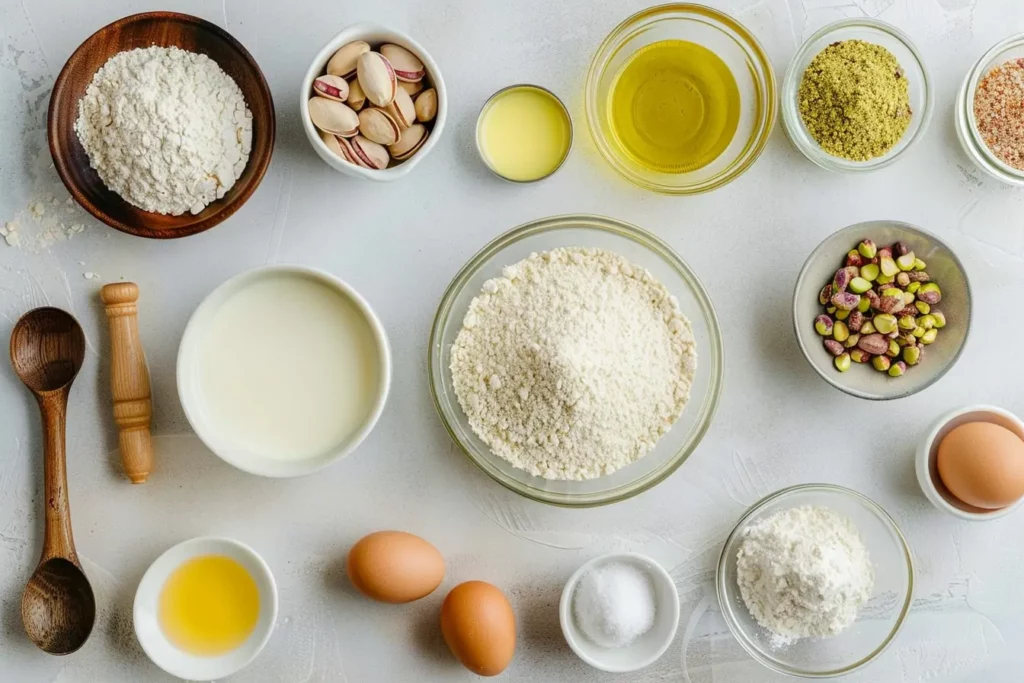
To avoid overpowering the cake, keep the butter-to-sugar ratio balanced and beat until fully whipped. A pale green tint adds visual appeal without food coloring if the pistachio paste is pure. The result is a smooth, nutty frosting that perfectly complements the subtle, earthy sweetness of pistachio cake.
If you don’t have pistachio paste on hand, try almond extract as a subtle backup. While not the same, it mimics the nuttiness enough to round out the flavor profile.
Cream Cheese, Mascarpone, and Other Options
Beyond buttercream, pistachio cake pairs well with tangy, creamy frostings. Cream cheese frosting offers just enough acidity to balance the natural richness of pistachios. Blend in a few tablespoons of Greek yogurt or sour cream for a silkier finish. For a gourmet twist, mascarpone cheese delivers a milder, ultra-smooth base—ideal for layered pistachio cake recipes.
For a lighter option, try whipped cream frosting stabilized with a spoonful of instant pudding mix. It holds up well, especially when serving pistachio cake in warm weather. Want a Mediterranean spin? Mix ricotta with a bit of honey and vanilla—this works wonderfully with orange zest or a drizzle of rosewater on top.
Here’s a quick table comparing frosting styles for pistachio cake:
| Frosting Type | Texture | Flavor Profile |
|---|---|---|
| Pistachio Buttercream | Creamy, dense | Nutty, sweet, intense |
| Cream Cheese | Smooth, slightly tangy | Balanced, rich, classic |
| Mascarpone | Light, velvety | Mild, luxurious |
| Whipped Cream | Airy, soft | Delicate, fresh |
| Ricotta-Honey | Slightly grainy, moist | Lightly sweet, floral |
Each frosting adds a unique twist to pistachio cake. Choose one based on the occasion, weather, or how sweet you want the dessert to taste.
Tips for Moist and Fluffy Pistachio Cake Texture
Key Baking Techniques for Moist Texture
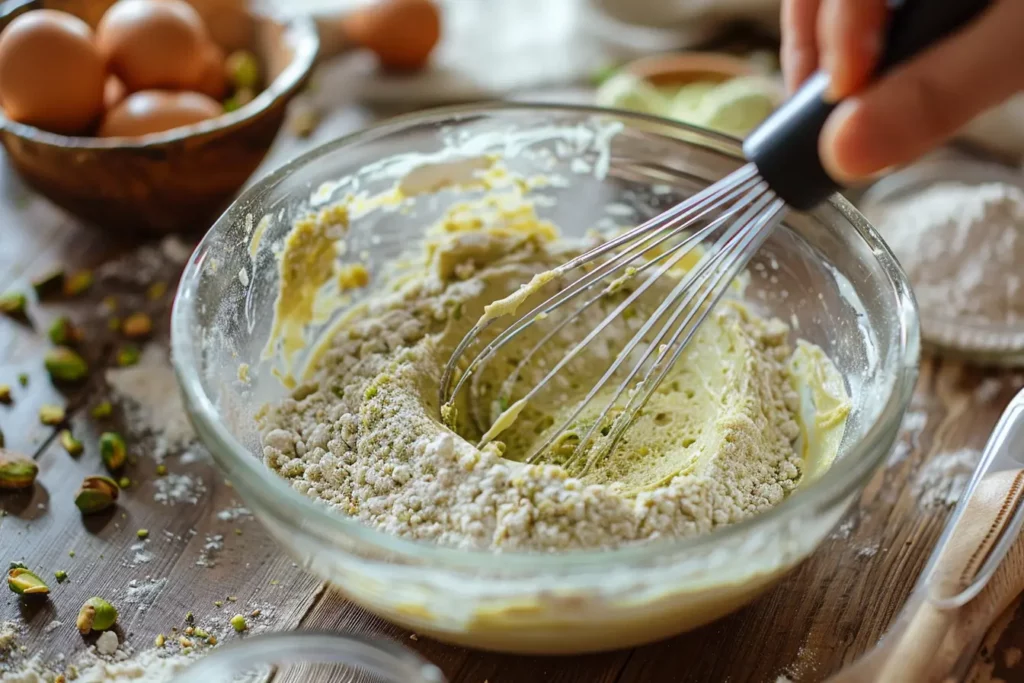
The secret to a perfectly moist pistachio cake starts with balance. Too much flour or overmixing can make it dense and dry. The best results come from using a mix of oil and butter. Oil adds moisture, while butter brings flavor. Full-fat Greek yogurt or sour cream also adds richness and prevents the crumb from drying out.
Use room-temperature ingredients. Cold eggs or milk can cause uneven mixing. Sift dry ingredients like flour, baking powder, and ground pistachios to keep the texture light. Add instant pistachio pudding mix only if you’re working with a boxed base—it helps retain moisture but isn’t necessary in scratch recipes.
For best results, follow the same techniques found in other Peanut Butter Pie . Also, always check doneness with a toothpick—if it comes out with moist crumbs, not wet batter, your pistachio cake is ready.
Common Mistakes That Dry Out Your Cake
Even small baking errors can ruin a pistachio cake’s texture. One of the most common is overbaking. Pistachio cakes are slightly denser due to the nut content, so they can appear underdone when they’re actually just right. Stick to the suggested bake time and always set a timer.
Another mistake is skipping the scale. Using cups instead of grams can throw off your ratio. For consistent results, weigh your ingredients. Many new bakers also forget to scrape the bowl between mixing stages. This leaves unmixed butter or sugar that affects texture and rise.
Using unsalted roasted pistachios instead of raw ones can also create bitterness and extra oiliness. Always check your nut source before blending into the batter. If you’re using chopped pistachios on top like in this Easy Strawberry Parfaits, lightly toast them but avoid burning.
Here’s a breakdown of mistakes and how to avoid them:
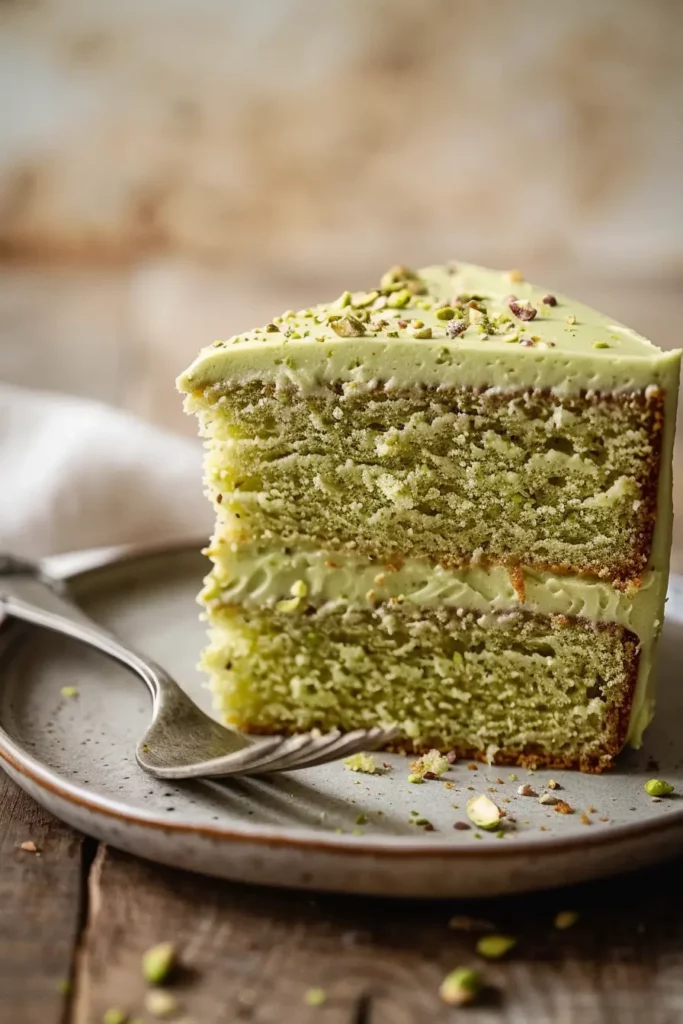
| Mistake | Effect on Cake | Fix |
|---|---|---|
| Overmixing the batter | Dense and tough cake | Mix until just combined |
| Overbaking | Dry texture | Check 5 minutes early |
| Cold ingredients | Uneven mixing | Bring to room temperature |
| Using roasted pistachios | Oily or bitter taste | Use raw, shelled nuts |
| Skipping the scale | Wrong ratios | Weigh all ingredients |
Follow these tips and your pistachio cake will always come out soft, fluffy, and delicious from the very first slice to the last bite.
Pistachio Cake Variations for Every Occasion
Pistachio Bundt Cake, Loaf, and Cupcakes
The beauty of pistachio cake lies in its flexibility. It works in classic round pans, but also shines in different formats like bundts, loaves, or cupcakes. Each version offers a different texture and presentation while keeping the same rich nutty flavor.
A pistachio bundt cake is ideal for holidays or family gatherings. Its denser crumb holds shape well, and the ridged edges catch every bit of glaze or crushed pistachio garnish. Pair it with a thin vanilla glaze or light lemon syrup for added shine and taste.
If you’re looking for something casual, a pistachio loaf cake works perfectly. It travels well and slices neatly. It’s great for potlucks, picnics, or weekday desserts. Add a touch of cardamom for a warm spiced note that enhances the pistachio flavor.
For smaller portions, pistachio cupcakes are a crowd-pleaser. Top with buttercream or cream cheese frosting and a sprinkle of chopped nuts. These are great for Banana Pudding Dip or school parties. You can even color the frosting naturally with matcha or spinach powder for a fun green look.
Pistachio Layer Cake for Birthdays and Events
For a celebration-worthy version, go with a pistachio layer cake. This format allows you to combine different frostings and fillings. A three-layer cake with pistachio buttercream, raspberry jam, or lemon curd in between turns every slice into a flavor surprise.
Layered cakes also allow you to play with texture. Add crushed pistachios between layers or mix in whipped cream frosting for a lighter feel.
Here’s a table to help you choose the right pistachio cake format based on your occasion:
| Cake Type | Best For | Topping or Frosting |
|---|---|---|
| Bundt Cake | Family dinners, holidays | Lemon glaze or vanilla icing |
| Loaf Cake | Casual gatherings, brunch | Simple glaze or powdered sugar |
| Cupcakes | Kids’ parties, birthdays | Buttercream, cream cheese |
| Layer Cake | Weddings, special events | Buttercream with fruit filling |
Whether you’re baking for a quick treat or a full event, the pistachio cake adapts easily. The flavor holds up well in any format, and the color adds a festive look without artificial dyes.
Flavor Pairings That Go with Pistachio
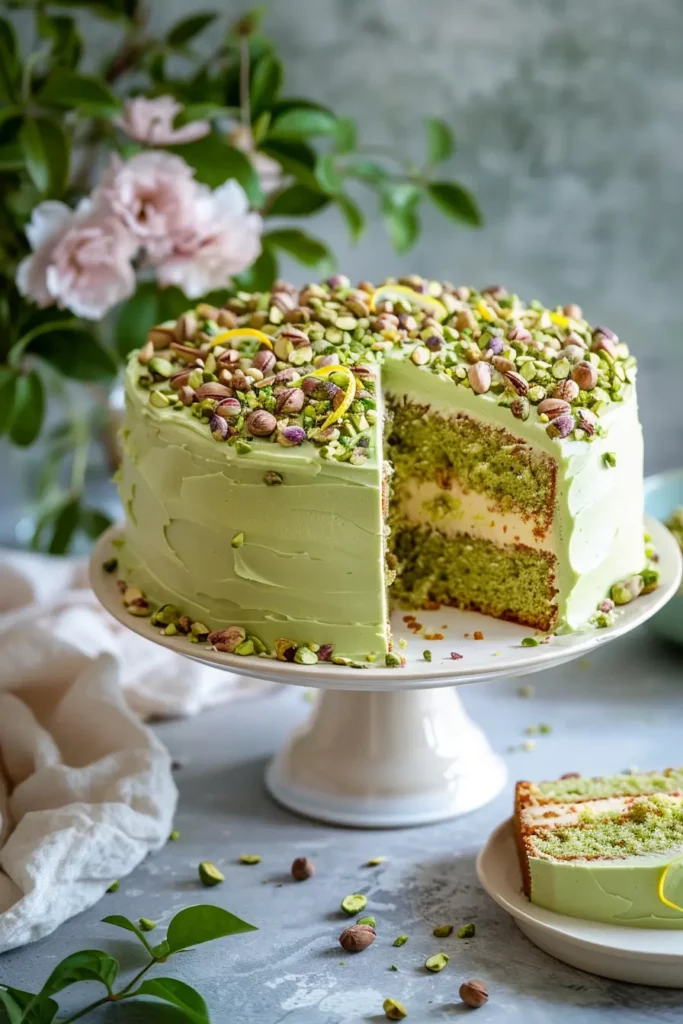
What Goes with Pistachio in Cake
Pistachio has a soft, nutty flavor that opens the door to dozens of amazing pairings. The right combo can turn a simple pistachio cake into a layered experience of sweet, tart, and rich notes. The top ingredients that go well with pistachio include chocolate, almond, cardamom, lemon, and berries.
Chocolate is one of the most reliable companions. A thin chocolate ganache or a drizzle of melted dark chocolate brings contrast to the nutty base. In fact, our Cheese Rolls often incorporate pistachios for added crunch and flavor complexity.
Citrus flavors like lemon and orange zest work beautifully, especially in glazes or fillings. Lemon’s brightness highlights pistachio’s earthiness without overwhelming it. You can even layer lemon curd into a springtime cake or try this Orange Pound Cake for a vibrant citrus twist.
Warm spices like cardamom and cinnamon round out the flavor, especially in fall or winter recipes. They bring a subtle heat that complements pistachio’s mildness. Cardamom especially enhances texture and warmth in bundt or loaf cakes.
Do Lemon, Raspberry, or Rose Pair with Pistachio?
Yes—lemon, raspberry, and rose are some of the best pairing options for a pistachio cake. Lemon sharpens the nut’s subtle flavor, making it more vibrant. Raspberry brings a gentle tartness that layers beautifully with creamy frostings like mascarpone or ricotta.
For a floral note, rosewater adds an elegant twist. Use it lightly—just a drop or two in glaze or whipped cream can bring a Mediterranean vibe. This style works best in holiday desserts or tea cakes, like these Cut Out Cream Cheese Sugar Cookies that also feature soft textures and delicate flavors.
Even stone fruits like apricot and cherry offer interesting contrast. A cherry compote on top of a pistachio base creates both color and boldness.
Here’s a quick reference table of ideal pistachio pairings in cake recipes:
| Flavor | How to Use | Result |
|---|---|---|
| Dark Chocolate | Drizzle or ganache | Rich, bold contrast |
| Lemon | Zest or glaze | Bright, refreshing |
| Raspberry | Jam or fresh berries | Tart, vibrant |
| Rosewater | Add to frosting | Elegant, floral |
| Cardamom | Mix into batter | Warm, spiced tone |
Don’t be afraid to mix and match these elements. A pistachio cake with raspberry filling and lemon glaze delivers layers of color, texture, and flavor that stand out on any dessert table.
Pistachio Cake History & the Watergate Cake Name
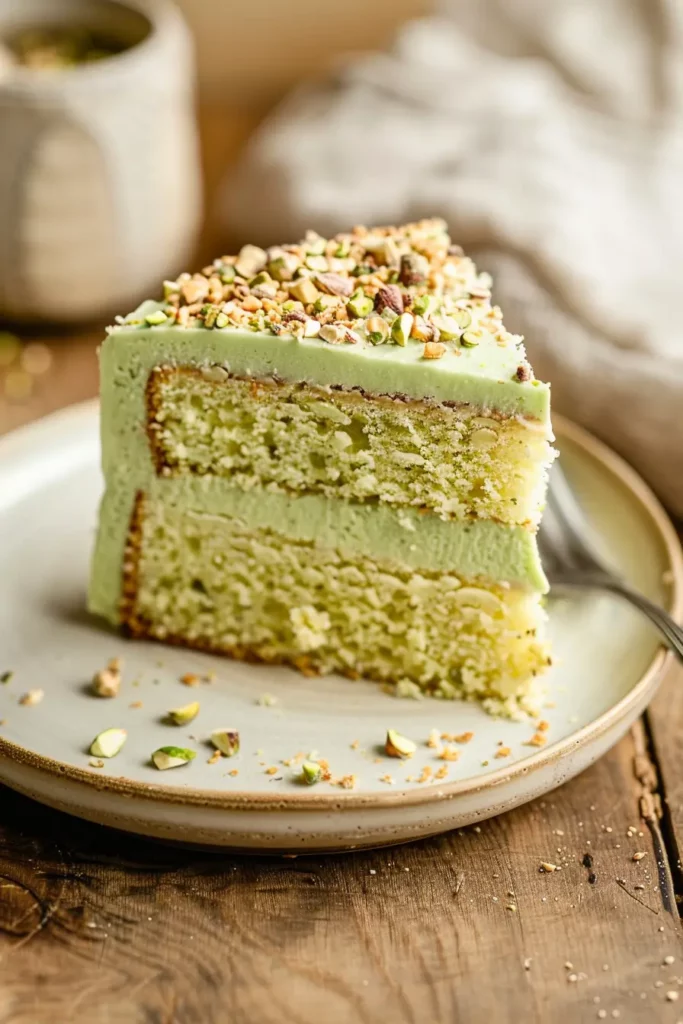
Why Is It Called Watergate Cake?
The pistachio cake became known as Watergate Cake in the 1970s, during one of the most talked-about political scandals in American history. The name wasn’t official but was widely used in home kitchens and local cookbooks. Some say it was created as a tongue-in-cheek reference to the scandal—sweet on the outside, with “nuts” inside.
The original Watergate cake included pistachio pudding mix, crushed pineapple, and whipped topping. It was moist, green, and topped with a creamy, fluffy frosting—often called “Cover-Up Icing.” This nod to the Watergate scandal gave the dessert a cheeky appeal that spread quickly.
Kraft introduced pistachio pudding mix in 1975, and many believe the cake became popular shortly after that launch. Combining the pudding mix into a boxed cake base gave home bakers an easy way to create a unique, colorful treat. Even today, many retro dessert recipes—like these No Bake Peanut Butter Cookies—keep that spirit of simplicity and nostalgia alive.
The Rise of Pistachio Desserts in America
Before the 1970s, pistachios weren’t a typical baking ingredient in the U.S. They were seen more as a snack nut or a component in Middle Eastern and Mediterranean cuisine. But the introduction of pistachio-flavored mixes helped launch a wave of new recipes, including pistachio cake, salads, cookies, and ice cream.
In the 1980s and 90s, the cake gained new attention as home bakers started experimenting with real pistachios instead of relying on boxed mixes. That shift added more texture, flavor, and freshness to the dessert. Today, it’s common to see scratch-made pistachio cake on spring menus, wedding buffets, or featured in creative layer cake recipes—often alongside fruity classics like these Easy Strawberry Parfaits.
Baking blogs and Pinterest helped revive the cake’s popularity in the 2010s, focusing on natural ingredients, stunning visuals, and nostalgic charm. The green hue became a symbol of freshness and flavor rather than artificial color.
Here’s a timeline overview of pistachio cake’s popularity:
| Decade | Milestone | Impact |
|---|---|---|
| 1970s | Watergate scandal; boxed mix versions gain fame | Widespread popularity among home bakers |
| 1980s–90s | Shift toward using real pistachios in baking | Improved taste and texture |
| 2000s | Pistachio flavors featured in gourmet shops | Viewed as premium dessert flavor |
| 2010s–Today | Pinterest and food blogs revive the classic | Nostalgic and trendy once again |
Whether you go vintage with pudding mix or make it from scratch, the pistachio cake remains a dessert full of character and charm.
Storage, Serving, and Make-Ahead Tips
Does Pistachio Cake Need Refrigeration?
Yes, but it depends on how your pistachio cake is frosted. If you’re using a dairy-based topping like cream cheese or mascarpone, you should refrigerate it after two hours at room temperature. These frostings contain ingredients that spoil if left out too long.
However, if your cake uses a simple buttercream or glaze, you can store it covered on the counter for up to two days. After that, it’s best to transfer it to the fridge for freshness. To prevent it from drying out, place the cake in an airtight container or wrap it tightly in plastic wrap.
When serving cold cake, let it sit at room temperature for 30 minutes to bring back its soft texture. The flavors of pistachio cake tend to deepen overnight, especially when the cake is made from scratch using real nuts—just like in this Orange Pound Cake that uses citrus and butter for bold, lasting flavor.
Best Way to Store for Freshness
To keep your pistachio cake fresh and flavorful for days, follow these simple rules based on frosting type and cake format. If you baked cupcakes, they store best in airtight containers with paper liners to prevent sticking. Layer cakes should be stored uncut as long as possible—exposed slices dry out quickly.
For long-term storage, freezing is a great option. Wrap unfrosted cake layers in two layers of plastic wrap and one layer of foil. Label and freeze for up to 2 months. When ready to serve, thaw in the refrigerator overnight and frost the next day.
If you’ve already frosted your cake, you can still freeze it. Just freeze uncovered for 1 hour to firm up the frosting, then wrap tightly. This works well for buttercream and cream cheese but not for whipped cream or fruit-based glazes.
Here’s a comparison table
| Storage Method | Shelf Life | Best For |
|---|---|---|
| Room Temperature | 1–2 days | Glazed or buttercream-frosted cakes |
| Refrigerated | Up to 5 days | Cakes with dairy frostings like cream cheese |
| Frozen (Unfrosted) | Up to 2 months | Make-ahead layer cakes |
| Frozen (Frosted) | 4–6 weeks | Buttercream and cream cheese cakes |
Baking with Pistachios 101

Are Pistachios Good for Baking?
Absolutely—pistachios are excellent for baking. Their mild, sweet flavor, vibrant color, and soft texture make them perfect for desserts, especially pistachio cake. They blend well into batters, mix easily into frosting, and add a delicate crunch when used as toppings.
Raw, unsalted pistachios are best for baking. They offer clean flavor and won’t introduce unwanted saltiness. You can grind them into flour, chop them for texture, or turn them into a creamy paste. In fact, many homemade pistachio cake recipes rely on pistachio flour for both flavor and moist texture—just like you’ll find in homemade nut-based recipes such as our Cheese Rolls.
Roasted pistachios add depth but may also bring oiliness, so use them only in small amounts or as garnish. If your pistachios have skins, rub them off after a quick blanch for a brighter green tone—perfect for frosting or decoration.
Pistachios work well in cookies, muffins, biscotti, and layered cakes. Just like almonds or pecans, they remain stable when baked and don’t lose flavor under heat.
Do Pistachio and Lemon Go Together?
Yes, pistachio and lemon are a fantastic match. Lemon’s acidity cuts through the natural richness of pistachios and enhances their flavor. The pairing works well in pistachio cake, especially when layered with lemon curd, drizzled with citrus glaze, or topped with lemon zest.
In many Middle Eastern and Mediterranean desserts, pistachio and lemon appear together in syrups or pastry fillings. The lemon brings out the fresh, nutty aroma of pistachio without overpowering it.
To help decide how to prep your pistachios for baking, here’s a quick guide:
| Pistachio Form | Use in Cake | Best For |
|---|---|---|
| Raw, shelled whole | Roast or grind before use | Making flour or paste |
| Chopped pistachios | Mix into batter or sprinkle on top | Toppings and texture |
| Pistachio flour | Blend with wheat flour | Flavor and moist crumb |
| Pistachio paste | Add to frosting or batter | Intense flavor boost |
Try combining pistachio flour and lemon zest in your next cake. You’ll get a naturally colorful and aromatic base that’s perfect for spring dessert tables—just like in this bright, citrusy Orange Pound Cake that’s a seasonal favorite.
Frequently Asked Questions About Pistachio Cake
What goes with pistachio in a cake?
Pistachio pairs well with a range of ingredients in desserts. Lemon, dark chocolate, raspberry, almond, and cardamom are all excellent choices. For a refreshing twist, use lemon zest in the batter or glaze. A drizzle of dark chocolate adds richness. Raspberry jam between layers creates balance, especially in a layered pistachio cake.
Why is pistachio cake called Watergate cake?
The term “Watergate Cake” became popular during the 1970s Watergate scandal. The original recipe used boxed pistachio pudding mix, crushed pineapple, and whipped topping. Some say the name was a playful reference to the scandal—a sweet cake with “nuts” inside.
What flavor pairs well with pistachio?
Lemon is one of the best flavors to pair with pistachio. Its brightness cuts through the nutty richness. Other great pairings include vanilla, orange zest, and dark chocolate. These flavors enhance the natural profile of pistachio cake without overpowering it. For more contrast, layer pistachio cake with tart fruit fillings like raspberry or cherry.
Does pistachio cake need to be refrigerated?
Yes—if your cake uses cream cheese, mascarpone, or whipped cream frosting. These toppings require refrigeration within two hours of serving. Cakes with simple buttercream or glaze can stay at room temperature for up to two days, but should be covered tightly. Always refrigerate leftovers to maintain moisture and freshness.
Are pistachios good for baking?
Definitely. Pistachios are soft, flavorful, and easy to grind or chop. They’re perfect for cakes, muffins, cookies, and even pie crusts. In pistachio cake, they add both flavor and color. Use raw, unsalted pistachios to avoid bitterness. Grind into flour, fold into batter, or sprinkle on top for texture. Pistachio paste also works well in frosting.
Do pistachio and lemon go together?
Yes—they’re a perfect match. Lemon adds brightness that enhances the nutty depth of pistachio. Use lemon zest in the cake batter or drizzle a lemon glaze on top.
Final thoughts
The pistachio cake stands out as a unique dessert—flavorful, moist, and adaptable. Whether you bake it as a bundt, a loaf, or a layered celebration cake, pistachio brings natural color and rich texture to every bite. From frosting choices to flavor pairings like lemon or raspberry, this cake allows endless creativity.
If you’ve never tried baking with pistachios before, now’s the time. Start simple, or build on classic formats like those in these easy celebration cake ideas such as our citrus-forward Orange Pound Cake. Whether it’s for a birthday, holiday, or quiet weekend, pistachio cake brings elegance and flavor—no artificial tricks needed.
For more nut-based desserts and spring-friendly recipes, don’t miss our full collection of seasonal bakes, including reader favorites like these Cheese Rolls made with real ingredients and homemade love.
Follow us on Facebook and Pinterest for more comforting recipes, meal tips, and weekly Dessert inspiration.



